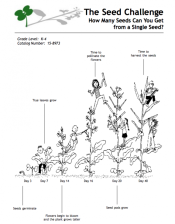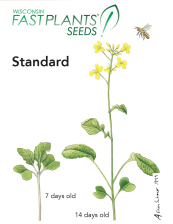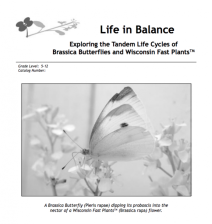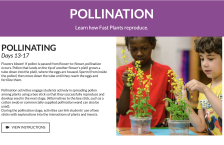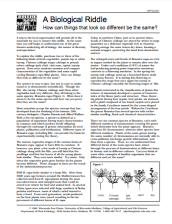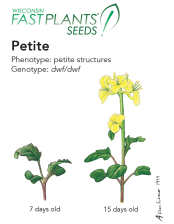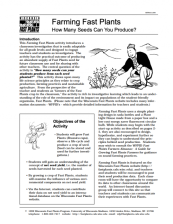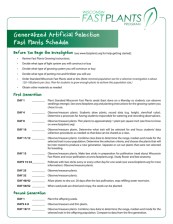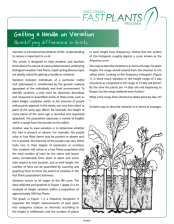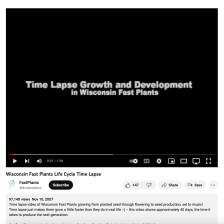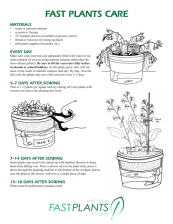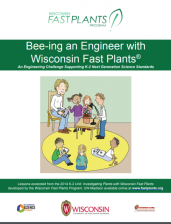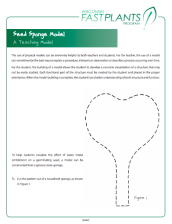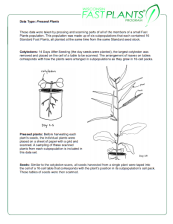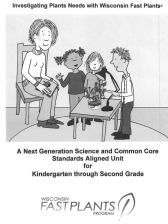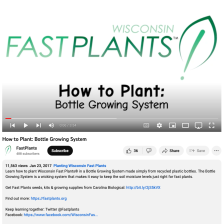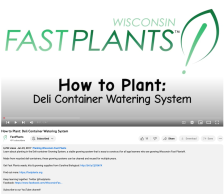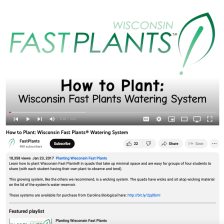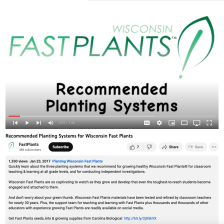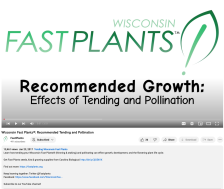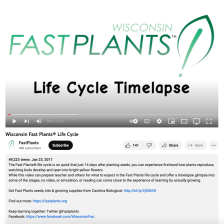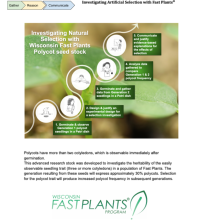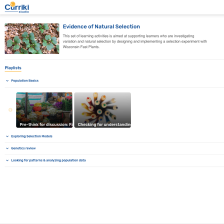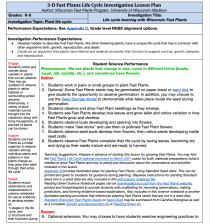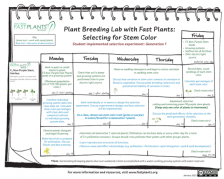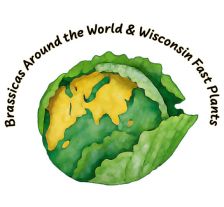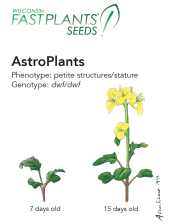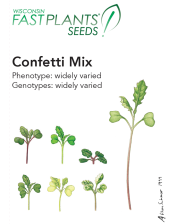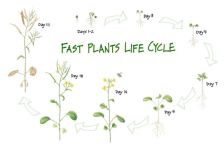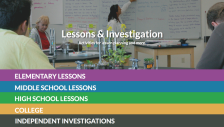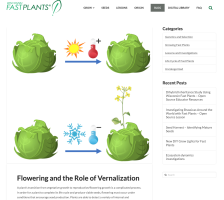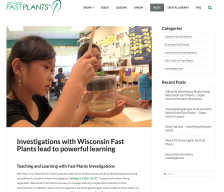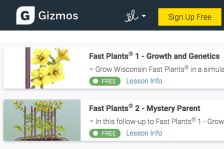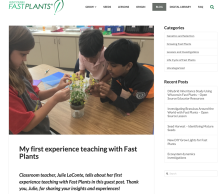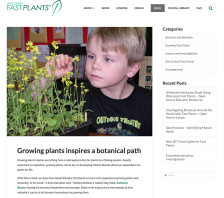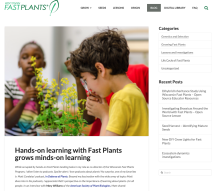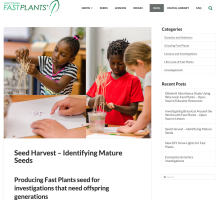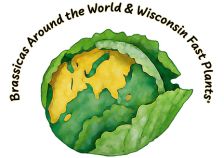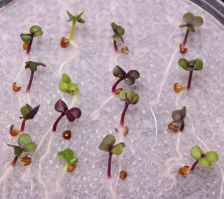Search Results
Searched for: Subject is Science -- Growth, development, life cycle
Resources 1 - 40 of 40
A 23-page PDF file (644 KB) with a complete set of activities for elementary students (also effective in middle school) to learn about the life cycle of flowering plants with a focus on reproduction. Students predict how many seeds their Fast Plant will produce and engage in planting, growing,...
This is a page on the Fast Plants website, describing the Standard variety of Wisconsin Fast Plants (Brassica rapa). This page includes suggestions for investigations and teaching applications using this seed variety, including use as a model organism to teach about the plant life cycle and plant...
Download this complete unit of instructions to conduct an ecosystem inquiry. In this investigation, students have the opportunity to witness first-hand the dynamic relationship between Brassica butterflies and Wisconsin Fast Plants. Students are responsible for tending the butterflies and plants...
This webpage from the Fast Plants website explains how to pollinate Fast Plants, including instructions for making bee sticks and pollination videos and tips.
Turnips, Chinese cabbage and Wisconsin Fast Plants (Rbr) look very different. Yet, they actually belong to the same species. This means that they have the same number of chromosomes and they can cross breed and produce fertile offspring. But how can you prove that plants that look so different are...
This is a page on the Fast Plants website, describing the Petite variety of Fast Plants (Brassica rapa). This page includes suggestions for investigations and teaching applications using this seed variety.
This Farming Fast Plants activity introduces a classroom investigation that is easily adaptable for all grade levels and designed to engage teachers and students as investigators. The activity has the practical outcome of producing an abundant supply of Fast Plants seed for future classroom use and...
This fill-in-the-blank timeline is a planning tool for teachers to use when figuring out when to begin the steps associated with conducting a two-generation artificial selection experiment using Fast Plants. Teachers preparing for any selection experiment will find this timeline helpful, including...
This article is designed to help students and teachers think about the nature of various determinants underlying biological variation. Teachers facilitating any selection investigation will find this background information helpful, including those planning for the AP Biology Lab 1 of Big Idea 1:...
On YouTube: Time lapse video of Wisconsin Fast Plants growing from planted seed through flowering to seed production, set to music! Time lapse just makes them grow a little faster than they do in real life -- this video shows approximately 40 days, the time it takes to produce the next generation.
This four-page handout explains the key steps to follow when caring for Wisconsin Fast Plants (Brassica rapa) throughout their life cycle, from sowing through harvesting seeds. This handout includes information about the materials needed, methods for tending and caring for your plants, and...
Download this complete set of lessons for an elementary, NGSS-aligned inquiry that foregrounds engineering practices. During the days that are supported by this investigation, students observe flowers on their 14 to 16 day old Fast Plants along with bee structures, learning to connect how the shape...
This 2-page handout gives instructions for making the seed sponge model that was developed by the Wisconsin Fast Plants Program as a tool for learning about germination. Visualizing what is inside a seed and how those structures function during germination is modeled, using a simple kitchen sponge....
These data sets were meticulously collected by Dr. Paul Williams in an investigation in which we were interested in learning about how nutrient limitations effect a variety of easily observable and measureable Fast Plant traits. Observations were made and recorded at different points in the plants'...
Download this comprehensive, 60-page elementary unit that was co-developed by the Fast Plants Program and Emily Miller (ELA/science elementary science education specialist) who helped author the Next Generation Science Standards) as an exemplar for supporting three-dimensional learning. Developed in...
Sign up for a free account on the Gizmo website (https://www.explorelearning.com/index.cfm?method=Controller.dspFreeAccount) for free access to two simulations that were collaboratively developed by the teams at Explore Learning and the Wisconsin Fast Plants Program of the University of...
This video is provided by Wisconsin Fast Plants and demonstrates how to plant Fast Plants seeds using the Bottle Growing System. The video gives an overview of the materials necessary to grow with this method, and also provides step-by-step instructions guiding the process. This recording runs for...
This video is provided by Wisconsin Fast Plants and demonstrates how to plant Fast Plants seeds using the Deli Container Growing System. The video gives an overview of the materials necessary to grow plants with this method, and also provides step-by-step instructions guiding the process. This...
This video is provided by Wisconsin Fast Plants, and demonstrates how to plant Fast Plant seeds using a quad-planter and wicking reservoir system. The video gives an overview of the materials necessary to grow plants with this method, and also provides step-by-step instructions guiding the process....
This video is provided by Wisconsin Fast Plants, and introduces three recommended planting systems to use for planting Fast Plants seeds. The video gives an overview of the different methods: the Deli Container, the Wisconsin Fast Plants Watering System, and the Bottle Growing System. This recording...
This video is provided by Wisconsin Fast Plants and demonstrates how to tend and pollinate Fast Plants as they grow and develop. While both tending to and pollinating Fast Plants is the recommended approach, this video features an experiment to illustrate the effect that tending and pollination has...
This video is provided by Wisconsin Fast Plants, and introduces the plant life cycle. The video features a 40-day time lapse of the Fast Plants from seeds during germination, through flowering and reproduction, until harvesting seeds at the end of the cycle. This recording runs for 02:19 minutes in...
This lesson plan, from the University of Wisconsin-Madisons Wisconsin Fast Plants, is for a high school biology investigation into evolution and artificial selection while using Fast Plants polycot seeds. The lesson plan describes student science performance for in-classroom learning as well as...
This resource, provided by Wisconsin Fast Plants and CurrikiStudio, contains a set of six different learning activities that can be implemented in classrooms to teach natural selection. Organized in playlists, these interactive lessons guide students through understanding and applying knowledge of...
This comprehensive Open Source lesson plan is designed for Kindergarten through Middle School level students to learn about life cycles, plants needs, and plant structures & their functions through hands-on investigations with Wisconsin Fast Plants. Depending on the grade level, students engage at...
This document includes a timeline and calendar to serve as planning tools for teachers to use when figuring out when to begin the steps associated with conducting a two-generation artificial selection experiment using Fast Plants. This investigation focuses on selection for the stem color trait....
This investigation begins with a phenomenon that is evidenced in most every produce aisle: Many of the vegetables that botanists classify as Brassica look and taste different. This investigation aligns with middle and high school Next Generation Science Standards as well as with agricultural science...
This is a page on the Fast Plants website, describing the AstroPlants variety of Fast Plants (Brassica rapa). This page includes suggestions for investigations and teaching applications using this seed variety.
This is a page on the Fast Plants website, describing the Confetti Seed Mix variety of Wisconsin Fast Plants (Brassica rapa). Confetti Mix includes phenotypes from several Fast Plants varieties, including purple stem, non-purple stem, yellow-green leaf, rosette-dwarf, tall plant, petite, variegated,...
This blog post from the Wisconsin Fast Plants website describes the value of using Fast Plants as a model organism to teach plant life cycles at multiple grade levels. Content includes an overview of plant growth stages (including videos) and links to resources and activities that can enrich...
This blog post from the Wisconsin Fast Plants website provides an overview and list of resources for teaching life science topics with Wisconsin Fast Plants. This blog is primarily a point of reference for other Fast Plants teaching resources.
This blog post from the Fast Plants Team addresses the question "Do Fast Plants need Vernalization to Flower?". This post describes the concept of vernalization (requiring a cold period to induce flowering) and its role in regulating the development of flower structures in flowering plants. Some...
This blog post from the Wisconsin Fast Plants website describes the value of using Fast Plants as a model organism for biological and environmental investigations. This post is primarily an index of Fast Plants resources, providing prompts for teaching goals and suggesting Fast Plants kits...
This blog post on the Wisconsin Fast Plants website features the recently released Wisconsin Fast Plants genetics simulations, powered by ExploreLearning Gizmos. Sign up for a free account on the Gizmo website (https://www.explorelearning.com/index.cfm?method=Controller.dspFreeAccount) for free...
This blog post from the Wisconsin Fast Plants website is a guest post by classroom teacher, Julie LaConte, of Rossman School in Creve Coeur, MO. In this post, Julie describes her experiences researching, preparing for, and teaching with Fast Plants in her classroom. Thank you for sharing your...
This blog post shared on the Wisconsin Fast Plants website is a guest post by Daniel Murphy, author of the weekly blog Awkward Botany. In this post, Daniel shares his firsthand account of his experiences growing plants and becoming "a bona fide plant nerd." This post is a great example of the value...
This blog post on the Fast Plants website shares content from podcaster, Matt Candeias, host of the In Defense of Plants podcast. In an interview with Mary Williams of the American Society of Plant Biologists, Matt discusses the important connection fostered between physical experiences and...
This blog post from the Fast Plants team provides detailed advice and instructions on the ideal timing for harvesting Fast Plants seeds. It is important to harvest at the correct time, to ensure maximum seed viability for planting the next generation. This post addresses several frequently asked...
This blog post from the Wisconsin Fast Plants features open source educator resources, developed in 2023. These NGSS- and Ag-Standards aligned resources, named Investigating Brassicas Around the World with Fast Plants include a full lesson plan with supporting plant breeding activities, video about...
This blog post from the Wisconsin Fast Plants features open source educator resources, developed in 2023. These resources support the teaching of genetics concepts with tools focused on a Dihybrid Inheritance Study. This study provides a two-week approach for observing three generations of plant...
Publisherv
Creatorv
Languagev
Phenotypic Traitv
Genotypev
Speciesv
Materials Development Erav
Media Formatv
Audiencev
Subjectʌ
- ☐ Arts
- ☐ Educational Technology
- ☐ Foreign Languages
- ☐ Language Arts
- ☐ Mathematics
- ☐ Science
- ☐ Social studies
Resource Typev
Classificationv
Education Levelv
